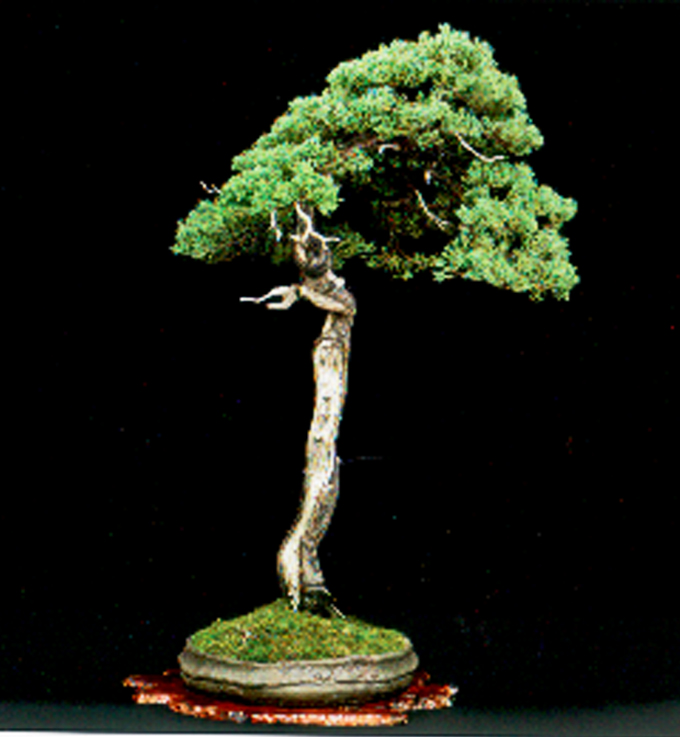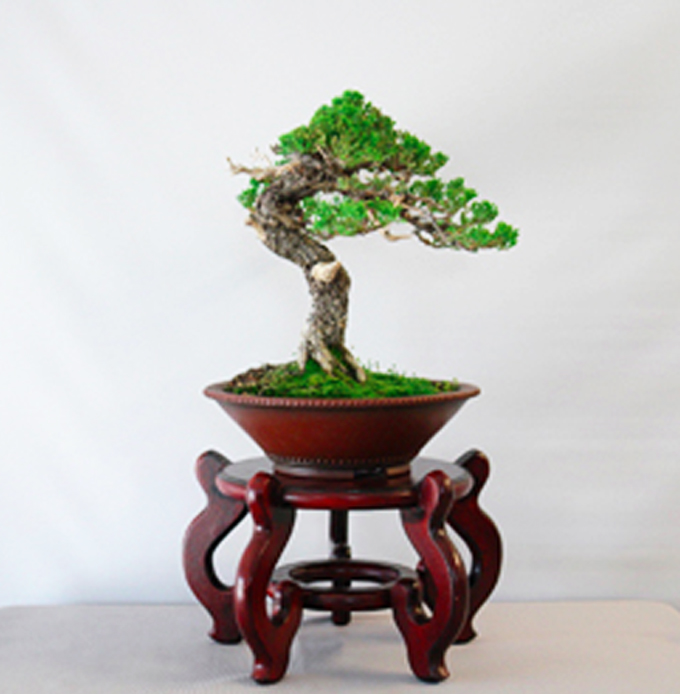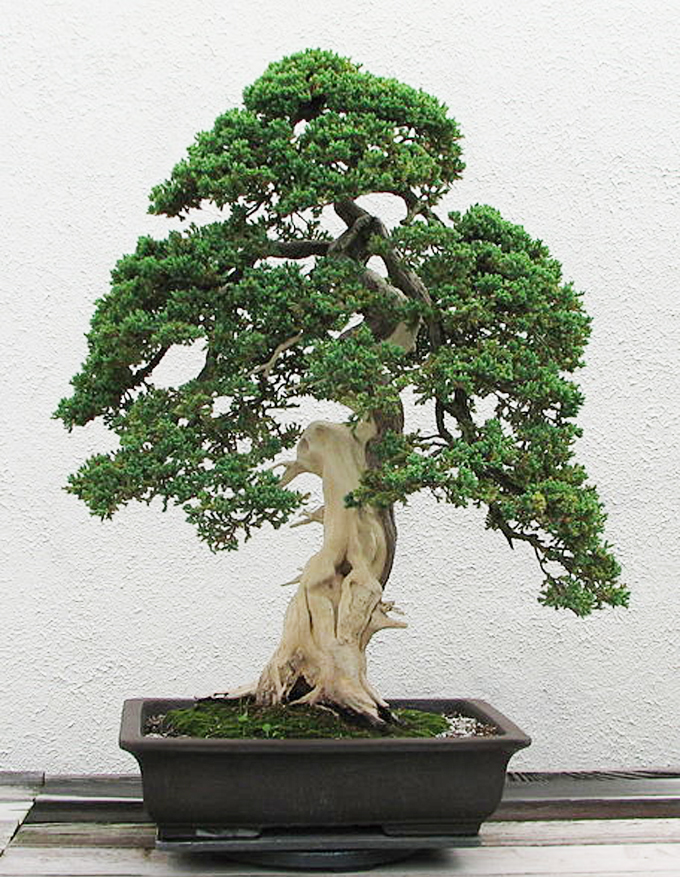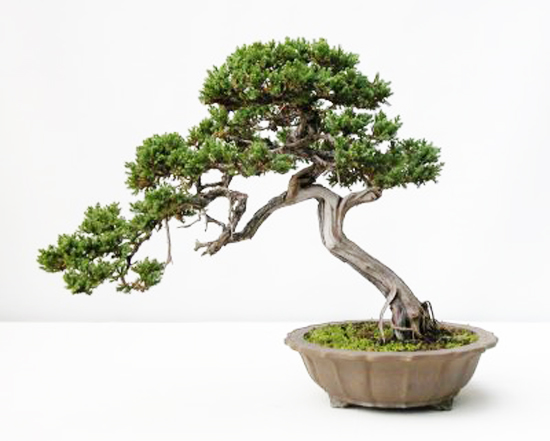 Dwarf Japanese Garden Juniper by Michael Sullivan. From the 3rd U.S. National Bonsai Exhibition Album (apologies for the fuzzy scan). One thing that stands out is how a combination of small touches soften the long, mostly straight, untapered trunk. First there’s the irregular pot which helps emphasize the small irregularities in the trunk. Then there’s the shari (deadwood strip) that adds movement and interest all the way up the trunk. Finally there’s the surprising little jin at the top of the trunk that further enhances the sense of movement (and adds a touch of humor).
Dwarf Japanese Garden Juniper by Michael Sullivan. From the 3rd U.S. National Bonsai Exhibition Album (apologies for the fuzzy scan). One thing that stands out is how a combination of small touches soften the long, mostly straight, untapered trunk. First there’s the irregular pot which helps emphasize the small irregularities in the trunk. Then there’s the shari (deadwood strip) that adds movement and interest all the way up the trunk. Finally there’s the surprising little jin at the top of the trunk that further enhances the sense of movement (and adds a touch of humor).
Japanese Garden Juniper bonsai
Shimpaku junipers rule. You see them everywhere and for good reason; they make excellent bonsai and because they grow wild in the mountains of Japan and have been collected and refined by some of the world’s great masters, they stand as some of the most amazing works of bonsai art on the planet. Still, there are a whole host of other junipers that make great bonsai, so I thought it might be worthwhile to start a Not Shimpaku series on some of these.
The Japanese garden juniper (Juniperus procumbens) and its dwarf cultivar (J procumbens ‘nana’) is a good place to start. In the U.S. at least, the dwarf ‘nana’ has long been the most popular beginner’s tree. For years you’d see young ones in malls (Mallsai) every holiday season and though they are not quite as popular now, you still see more than enough of them around. But you don’t see that many specimen quality Procumbens and you almost never see seldom see specimen Procumbens nana. Part of this is no mystery; Procumbens are slow to develop trunk girth and Procumbens ‘nana’ are even slower. Still, we’ve managed to dig up some worthwhile specimens.
 This little gem belongs to Thomas J. Mozden. I found it at The Art of Bonsai Project where it’s listed simple as Juniperus procumbens. But, to my eye (though it’s hard to tell in this somewhat fuzzy blow-up) the foliage looks like it might be a Procumbens nana.
This little gem belongs to Thomas J. Mozden. I found it at The Art of Bonsai Project where it’s listed simple as Juniperus procumbens. But, to my eye (though it’s hard to tell in this somewhat fuzzy blow-up) the foliage looks like it might be a Procumbens nana.
This Procumbens by Zhao Qingquan is also from the Art of Bonsai Project. A later version in a very interesting pot can be found Zhao excellent book, Penjing: The Chinese Art of Bonsai.
 This one is from a 2012 Bark post. The tree resides at the National Bonsai and Penjing Museum. It’s listed as a Procumbens nana, though I’ve never seen a ‘nana’ with such a massive trunk. Which begs the question… (the story is here).
This one is from a 2012 Bark post. The tree resides at the National Bonsai and Penjing Museum. It’s listed as a Procumbens nana, though I’ve never seen a ‘nana’ with such a massive trunk. Which begs the question… (the story is here).

Thanks Terry,
Yeah, I’ve noticed distinct differences in two similar junipers that are both often called procumbens pro-nana. One has slight greyish tint (your white striped leaflets) and the other is a much more robust bright green (sometimes called Green mound juniper in the vernacular).
So yeah, where’s our botanist?
wikinbf
2 #
wikinbf
terry davis
16 approved
bonsai.terry@gmail.com
75.168.27.107
Submitted on 2013/09/15 at 3:23 PM
Cliff Pottberg used to tell me that the thing we call J. procumbens nana is not. Subsequently, a wholesale nurseryman chimed in that the true procumbens nana is a rare plant, and that the one available in the trade is derived form prostrata. The real thing has a small white stripe on the back of each leaflet. Supposedly, the trees available from Steve Krattke are the procumbens. Could we get more input from a botanist?
A lot of us get away from the needle junipers because they bite, and seem to be more susceptible to juniper blight.
I don’t know why Terry’s comment didn’t show originally. It shows on the back end but didn’t come up here where it should, so I’ve copied it along with my reply (above).